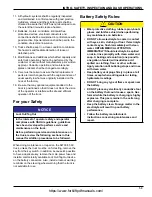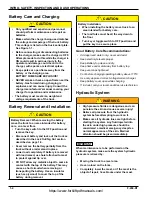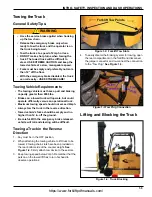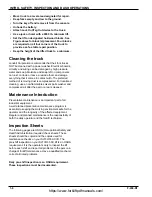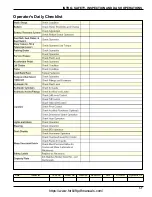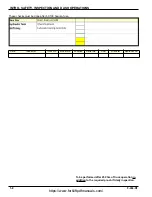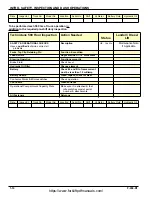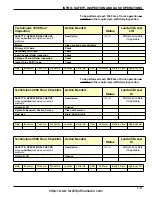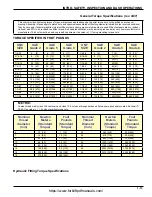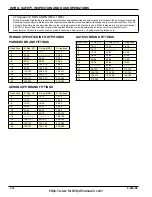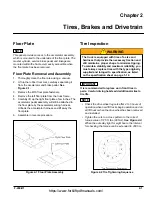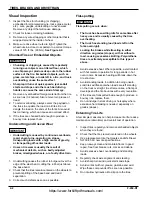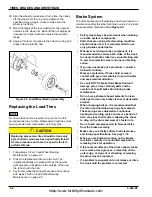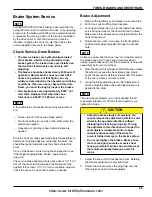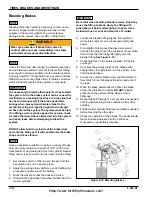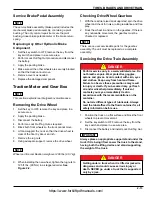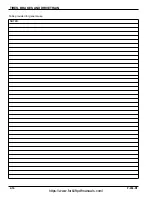
TIRES, BRAKES AND DRIVETRAIN
2-3
Replacing the Drive Tire
WARNING
CAUTION
1.
Park the truck at a level, designated work area.
2.
Lower the forks and chock the load wheels.
3. Turn the steer wheel all the way to the right to expose
the wheel mounting nuts.
4.
Remove the ignition key and place in a secure area.
5.
Perform a Lock Out/Tag Out procedure.
6.
Lift the truck so that the tire being replaced is just off
the floor.
7.
Remove the lug nuts to replace the rear drive tire.
8.
Replace tire only with a Landoll approved
replacement part.
9.
Press the replacement tire onto hub. The replaced
tire gets pressed off during this procedure. Make
sure the outside of the new tire is flush with the hub.
10. Install tire/hub assembly onto the truck and torque
lug nuts to 125 ft. lbs. (90 Nm.) in a cross-cross
pattern. See Figure 2-2.
Load Wheel Bearing
Maintenance
1.
Remove the ignition key and place in a secure area.
2.
Perform a Lock Out/Tag Out procedure.
3.
Jack and block the truck so the load wheel being
serviced is clear of the floor and free to rotate. Make
sure other wheels are securely blocked so the truck
cannot move.
4.
Spin the wheel and check for noise, rolling resistance
and free play. Rock the wheel in and out on the
spindle. If there is noticeable movement the bearings
should be checked and repacked with grease or
replaced if necessary.
5. To remove the wheel pry off wheel hub cover. Bend
back tangs on the lock washer to free them from the
notches in the wheel spindle nut. See Figure 2-3.
6.
Using a spanner wrench, unscrew the spindle lock
nut and pull hub/wheel assembly from the spindle
being careful not to damage the inner grease seal.
7.
Remove outer wheel bearing from hub.
8. To remove the inner wheel bearing turn the tire face
down and pry the old grease seal from the wheel.
Note how seal is installed.
9.
Remove the inner wheel bearing from the hub.
10. Carefully inspect the bearings for cracks, heat
discoloration, worn rollers, etc. Check the bearing
race for wear and/or damage.
11. If bearings need to be replaced, use a punch or wood
block to tap out the inner and outer races.
NOTE
Spindle nut can best be removed using Landoll p/n
176168, Tool, M-10SPANNER NUT.
12. Use solvent to remove all traces of old grease from
the wheel hub, spindle and bearings if new ones are
not being installed. Allow the parts to air dry.
13. Install a new inner and outer race (one each) in the
wheel hub if the bearings are being replaced. A seal
and race tool is required to press in the race.
14. Pack the bearings with high-temperature bearing
grease, making sure the grease penetrates the
rollers, cone and cage from the back side.
15. Also apply a thin coat of grease to the spindle at the
outer bearing seat, and to the inner surfaces of the
race.
16. Place the grease-packed inner bearing into the rear
of the wheel and put a little grease around the outer
edge of the bearing.
17. Place the new seal over the inner bearing and tap the
seal evenly into place using the seal and race tool.
The seal must be flush with the wheel hub.
18. Carefully place the wheel onto the spindle and push
the outer grease-packed bearing into position.
19. Install the tanged lock washer, then install the spindle
nut and tighten to 22 (±2) ft. lbs., 30 (±3) Nm. to seat
the bearings.
Make sure that a replacement drive tire is of the
same size and composition as the original tire
supplied by Landoll Corporation. Tire
composition can affect braking, capacity, turning
and operator safety. Landoll Drexel SLT30/35 AC
tires are an interference type, meaning the tires
are pressed on and pressed off. The rear drive
tire can be replaced separately, but the two front
tires should be replaced in pairs to maintain
performance and stability.
Replacing pressed-on tires should be done only
by technicians who have been specifically trained
for this procedure and have the specific tools to
perform this job.
https://www.forkliftpdfmanuals.com/

